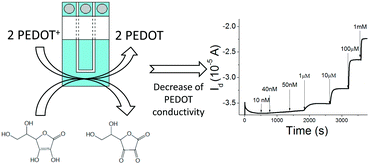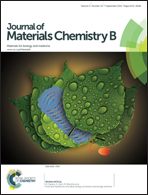A simple all-PEDOT:PSS electrochemical transistor for ascorbic acid sensing†
Abstract
An ascorbic acid (AA) sensor was developed by employing an organic electrochemical transistor (OECT) based only on PEDOT:PSS as a conductive material. The device was prepared by spin coating using the CLEVIOS™ PH 1000 suspension (PEDOT:PSS) masking the gate and the channel areas with tape. The device was electrically characterized while the doping level of the PEDOT:PSS in the channel was controlled using both the gate electrode and the potentiostat. It was demonstrated that the current that flows in channel (Id) is controlled by the concentration of oxidized sites in the examined potential range. AA reacts with the conductive polymer leading to the extraction of charge carriers from the channel, and thus resulting in a decrease of the absolute value of Id. It was observed that Id linearly depends on the logarithm of the AA concentration between 10−6 and 10−3 M. The OECT response to AA was studied by varying the gate voltage or the PEDOT:PSS thickness. The performance of the device for optimized conditions shows a limit of detection equal to 10−8 M and a sensitivity of 4.5 ± 0.1 × 10−6 A decade−1.


 Please wait while we load your content...
Please wait while we load your content...